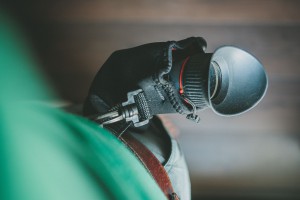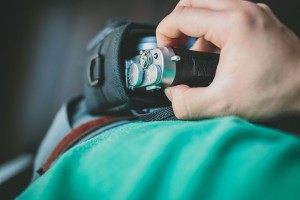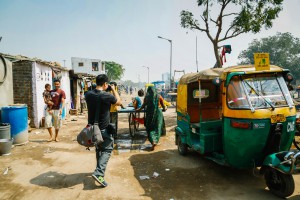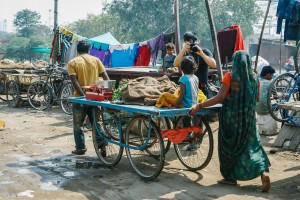This series of travel blogs from February 12th to March 1st is made possible by WIEGO. Georgia Street Media is proud to partner with Director/Producer Lori McNulty (http://www.lorimcnulty.ca/) to produce a short documentary for WIEGO and help tell the story of informal workers around the world and their health care issues.
After waking up at 1 a.m., pressing through the masses at the Ahmedabad airport, going though a ridiculous number of security checkpoints (I counted seven), then travelling for 16 more hours, we’ve finally arrived at our last stop: Durban, South Africa. We’re staying at this beautiful, sprawling, character guesthouse called the Durban Elephant and I’ve actually got my own little cottage set apart from the main house, which is very nice (either that or I smell bad). There are two other guests currently here – a mother and her adult son, whom we originally thought were a couple. Awkward.
Speaking of awkward, I went to the shared kitchen earlier this evening to get a drink, for which the payment system is to leave the appropriate amount of cash (10 rand for my can of pop) in a jar above the beverage fridge. Because a 50 rand note was the smallest denomination I had, I decided to toss that in the jar and grab some change for myself. However, once I stuck my hand through the small mouth of the container and grabbed a fistful of change, my greedy paw was too big to get back out.
As most of you are probably aware, this is of course a variation of a classic method in which monkeys are trapped in the wild. A hunter or collector will leave a jar of nuts in the jungle, and once a hapless monkey comes across it, it will go for the food and it won’t let go, even if its paw is stuck in the jar. At that point, the monkey is distracted and easily captured. It just so happens that there are actually monkeys crawling around this estate, of which I am apparently the most foolish.
Sometimes I have good ideas though and I learn a thing or two from my experiences. I’m by no means an expert on globetrotting while filming, but I have done it a handful of times before. Here’s some of what I’ve learned on this trip:
1. Wear Pants
Don’t worry, even though I was homeschooled, I’m not so socially backward as to suggest that I didn’t used to wear pants on shoots. I’m speaking about long pants, specifically. I personally hate wearing anything but shorts when working in hot climates, but when I got word that anything above the knee would be culturally offensive in the area we were going to in India, I decided I should buy some big boy pants. And I’m so glad I did. Yes, it was definitely warmer and more uncomfortable than shorts, but when you’re literally crawling around in the dirt in some back alley slum to get a shot, you’ll be glad for all the lower-limb coverage you can get. Especially in India where sitting cross-legged on the floor while working can be the norm, I found myself shooting a lot of interviews kneeling for long periods of time in unknown substances.
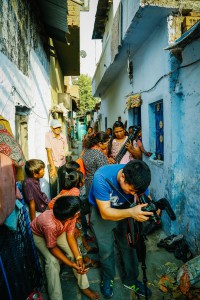
I bought some lightweight, well-ventilated, and water repellent Columbia pants from Sport Chek (I did not get paid to say that) and they served me and my calves very well – Photo by Lori McNulty
2. Attach things to your belt. It’s convenient and just feels cool
Because I’m constantly switching between shooting video and stills on my Canon 5D Mark III, I need to gear up a little more than if I was just a videographer or a photographer and not doing both simultaneously. When I’m in a video mode, at the bare minimum I have an ND filter mounted to the front of my lens (which is vital for controlling exposure while maintaining that 1/50th shutter speed, f/2.0 aperture, and low ISO) and an LCD viewfinder magnetized to the back of the camera, which is critical for actually seeing what you’re shooting in the bright sun, as well as giving you a third point of contact for extra handheld stability. The problem is that say I get the footage I need and then decide I also want a still picture of the same subject – I need to quickly remove my ND filter and LCD viewfinder before the shot changes. That’s where my left belt pouch comes in handy. I keep those accessories there when I’m in photo mode and have easy access to them when I need to go back to shooting video.
When I just don’t have time to take off and put away the filter and viewfinder (not to mention adjusting a lot of other settings on the camera to switch from stills to video and back), I’ve always got my Fuji X100s in my right holster, ready for the quick draw. It’s a great little camera that is actually superb for this kind of quick street photography as it’s much more unobtrusive and subtle than a big DSLR. The fixed 23mm f/2.0 lens (roughly 35mm with the crop factor) is a very useful focal length for street shots as well; and the quality is undeniable.
3. Bring duct tape
I always travel with a big roll of duct tape, and I have no shame in admitting it. I’ve used it to fix broken luggage, rig up production equipment, and even bandage wounds sustained the on the job (it kept me from bleeding all over during the shoot, but it’s still a last resort patch). You can also use it to make duct tape wallets, roses, and ties if you get bored. All of which I have done, but that’s a story for another time.
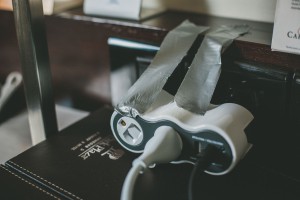
I used it all last week to support my sophisticated travel adapter + surge protector combo system
4. Bring tools so that you don’t become one during a shoot
Allen keys, screw drivers, and dozens of other odds and ends – all things that can help you fix, modify, and upgrade your gear on the go. Most tripods, monopods, shoulder rigs, and sliders require some regular adjustments (usually with a specific allen key) to keep things tight and smooth. The last thing you want when shooting an important interview is a tripod leg that won’t lock in place, so make sure you bring the right tools, and even bits and pieces that you don’t think you’ll need.
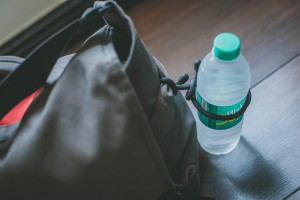
For example, I bought a bunch of these rubber-coated heavy duty twist ties. They’re great for things like attaching an intervalometer to your panhandle or keeping your water bottle nearby.
5. Be flexible
Sometimes you can take your time to set up the perfect shot, choosing just the right lens, camera support, and block it out. But as is so often the case with language barriers and foreign cultures, you have to eschew all that and sometimes just sprint madly with what you have after a rickety vegetable cart because the family pushing it doesn’t understand you and can’t wait to get their wares to market. And you know what? That’s ok.

